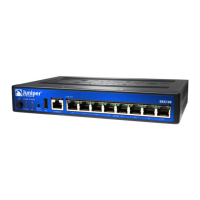The SSH client software must be installed on the machine where the client application
runs. If the SSH private key is encrypted (for greater security), the SSH client must
be able to access the passphrase used to decrypt the key.
For information about obtaining SSH software, see http://www.ssh.com and
http://www.openssh.com.
If you are using a JUNOScript server to configure and monitor devices, you can
activate cleartext access on the device to allow unencrypted text to be sent directly
over a Transmission Line Protocol (TCP) connection without using any additional
protocol (such as SSH, SSL, or Telnet). For more information about the JUNOScript
application programming interface (API), see the JUNOScript API Guide.
NOTE: Information sent in cleartext is not encrypted and therefore can be intercepted.
If the device is operating in a Common Criteria environment, see the Secure
Configuration Guide for Common Criteria and JUNOS-FIPS.
Related Topics ■ SRX100 Services Gateway Basic Connectivity Overview on page 55
■ SRX100 Services Gateway Basic Connectivity Settings on page 56
■ Built-In Ethernet Ports for the SRX100 Services Gateway on page 58
■ Connecting an SRX100 Services Gateway to the J-Web Interface on page 60
■ Connecting an SRX100 Services Gateway to the CLI Locally on page 62
■ Connecting an SRX100 Services Gateway to the CLI Remotely on page 64
Connecting to an SRX100 Services Gateway
This topic includes the following sections:
■ Connecting an SRX100 Services Gateway to the J-Web Interface on page 60
■ Connecting an SRX100 Services Gateway to the CLI Locally on page 62
■ Connecting an SRX100 Services Gateway to the CLI Remotely on page 64
■ Connecting the Modem at the SRX100 Services Gateway End on page 64
■ Connecting the Modem to the Console Port on the SRX100 Services
Gateway on page 65
■ Connecting to the CLI at the User End for the SRX100 Services
Gateway on page 66
Connecting an SRX100 Services Gateway to the J-Web Interface
If you plan to use the J-Web interface to configure the SRX100 Services Gateway,
you must connect through one of the built-in Ethernet management ports.
60 ■ Connecting to an SRX100 Services Gateway
SRX100 Services Gateway Hardware Guide

